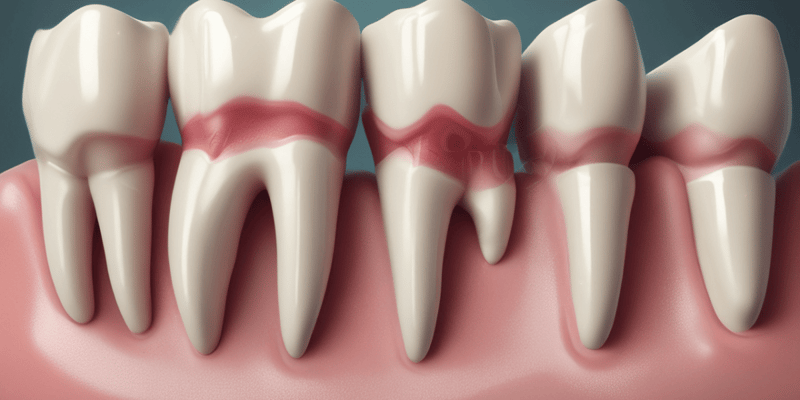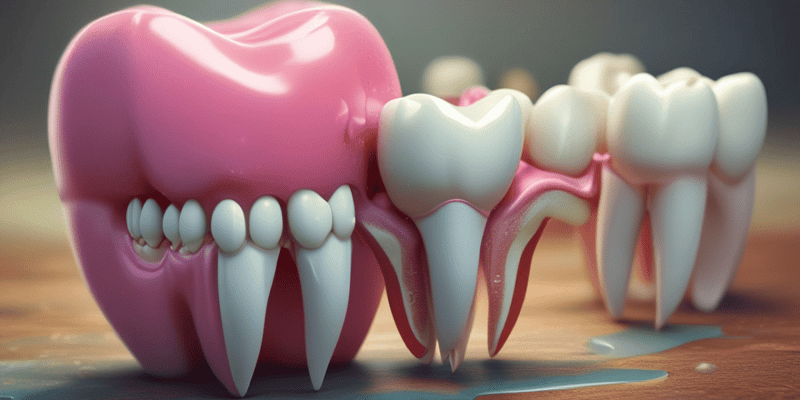40 Questions
What is the primary goal in removing remaining carious dentin or old restorative material?
To eliminate any infected dentin and old faulty restorative material
What is the characteristic of the floor of the cavity?
Composed of hard, sound, and healthy dentin
What is the CP depth in the floor of the cavity?
0.2 mm beyond the DEJ
What is stained dentin?
Dentin stained from pigments produced by chromogenic bacteria
What is the difference between infected dentin and affected dentin?
Infected dentin is contaminated, while affected dentin is not
What is the main problem with using color alone to determine how much dentin to remove?
It may lead to over-cut remineralizable dentin
What is the characteristic of the outer layer of carious dentin?
Soft, infected, and contaminated with bacteria
What is the characteristic of the inner layer of carious dentin?
Slightly softened, demineralized, and not stained by dye
What is the purpose of using caries-disclosing dyes?
To aid in the decision of how much dentin to remove
What type of rotary instrument is used for removing old restorations?
Round carbide burs with high-volume evacuation
What is the purpose of using caries detection dyes?
To selectively stain infected dentin
What is the direction of movement for a sharp spoon excavator?
Parallel to recessional lines of the pulp
What is the method of using round carbide burs at low speed?
With water cooling and intermittent strokes
What is the term for dentin that can remineralize?
Affected dentin
Why is it important to use high-volume evacuation when removing old restorations?
To prevent mercury vapor inhalation
What is the decision of how much dentin to remove based on?
An empirical decision enhanced by practical knowledge and experience
What is the main concern with deep dentin?
It is susceptible to desiccation
Why is it essential to place liners and bases?
To receive the final restorative material
What is the recommended distance between the pulp and restorative material?
2-mm
What is the purpose of secondary retention and resistance features?
To enhance retention and resistance form
Where are proximal axial grooves typically prepared?
At the axio-buccal and axio-lingual line angles
What tool is used to prepare axial coves?
No. ¼ round bur
What is the purpose of horizontally oriented axial retention grooves?
To enhance retention in Class V preparations
What is the benefit of preparing skirts in extensive Class IV, cast gold restorations?
Both A and B
What is the purpose of preparing horizontal slots in dentin?
To improve the retention of the restoration
What is the primary function of pins in a restoration?
To improve the retention of the restoration
What is the main advantage of beveling enamel margins for cast metal restorations?
It affords a better junctional relationship between the metal and the tooth
What is the objective of developing a specific cavosurface design when finishing external walls and margins of a composite restoration?
To create the best marginal seal possible between the restorative material and the tooth structure
What is the ideal method for achieving a smooth marginal junction in a restoration?
By smoothing the walls for better adaptation
What type of restorations would benefit from a 90-degree cavosurface angle?
Amalgam and ceramics
What is the purpose of using a hand cutting instrument in enamel wall finishing?
To shape and refine the enamel walls
What is the purpose of beveling for intra-coronal cast gold restorations?
To afford a better junctional relationship between the metal and the tooth
What is the ideal outline for a finished enamel wall in a restoration?
A sweeping curve
What is one of the objectives of cleaning a cavity?
To prepare the tooth surface for a selected restorative material
What is a contraindication for cleaning a cavity?
Using chemicals to clean or sterilize the cavity
What is the purpose of flushing the cavity with air-water spray during cleaning?
To remove bacteria and debris
What is the purpose of using a solution containing 5% glutaraldehyde and 35% hydroxyethyl methacrylate (HEMA)?
To restrict tubular fluid movement and sensitivity
What is the result of excessive dryness with air blast during cleaning?
Dentin dehydration with subsequent post-operative hypersensitivity
What is the first step in the technique of cleaning a cavity?
Scraping the cavity walls and floors with a hand instrument
What is the purpose of drying the cavity with cotton pellets during cleaning?
To gently dry the cavity before using oil-free air blowing
Study Notes
Removal of Remaining Carious Dentin or Old Restorative Material
- Teeth with frank deep carious lesions require removal of infected dentin and old faulty restorative material after initial tooth preparation.
- The floor of the cavity may be composed of:
- Hard, sound, healthy dentin (free from lateral spread of decay or discoloration, with a CP depth of 0.2 mm beyond the DEJ)
- Hard but discolored dentin (stained from pigments produced by chromogenic bacteria, not considered carious)
- Carious dentin (area of decalcification precedes penetration of microorganisms, often appears discolored, but has no soft texture of caries)
Carious Dentin
- Carious dentin is formed of two distinct layers:
- Infected dentin (outer layer, softened, contaminated with bacteria, includes superficial, granular, necrotic tissue, and softened, dry, leathery dentin)
- Affected dentin (inner layer, slightly softened, demineralized dentin, not invaded by bacteria)
- Clinically, carious dentin is characterized by:
- Infected dentin: soft texture, discolored, bacterial invasion, non-vital, no pain
- Affected dentin: slight softening, demineralization, not invaded by bacteria, vital, painful
Techniques for Removal of Carious Dentin
- Rotary instruments: carbide bur, ceramic bur, CMCR
- Directions for removal:
- Moderate, deep, extensive caries: use soft or hard caries removal techniques
- Tools: hand (soft) or rotary (hard)
Pulp Protection
- Deep dentin is very porous and susceptible to desiccation
- The thin remaining dentin provides little protection from:
- Heat generated by rotary instruments
- Noxious ingredients of various restorative materials
- Thermal changes conducted through restorative materials
- Forces transmitted through materials to the dentin
- Ingress of bacteria and toxins
Secondary Retention and Resistance Features
- Proximal axial grooves (locks): prepared at the axio-buccal and axio-lingual line angles in extensive cavity preparations
- Axial coves: prepared with a No. ¼ round bur
- Horizontally oriented axial retention grooves: prepared in most Class V preparations for amalgam and in some root surface tooth preparations for composite
- Skirt: preparation features used in extensive Class IV, cast gold restorations that extend the preparation around some or all of the line angles of the tooth
- Horizontal Slots: retentive groove in dentin, prepared approximately 0.6 mm deep and 0.5 to 1 mm inside DEJ
- Pins: pin retention used in preparation with few or no vertical walls
Finishing External Walls and Margins of CP
- Objectives:
- Create the best marginal seal possible between the restorative material and the tooth structure
- Afford a smooth marginal junction
- Provide maximum strength of both the tooth and the restorative material at and near the margin
- Ideal finished enamel wall is gained by:
- Removal of undermined enamel
- Adjustment of CSA according to the physical properties of the restoration
- Smoothening of walls for better adaptation
- Making the outline in sweeping curves
- Rounding of line and point angles
Cleaning and Preparation of the Cavity
- Objectives:
- Removal of bacteria, loose caries debris after using sharp excavator, temporary restoration, and saliva
- Improvement of adaptation and avoidance of caries recurrence around the restoration
- Preparation of the tooth surface to receive the selected restorative material
- Technique of cleaning:
- Scrap the cavity walls and floors with a hand instrument
- Flush the cavity with air–water spray
- Dry the cavity with cotton pellets, then gentle dryness with oil-free air blowing
This quiz covers the steps and considerations for eliminating infected dentin and old restorative material during tooth preparation, including the composition of the cavity floor.
Make Your Own Quizzes and Flashcards
Convert your notes into interactive study material.
Get started for free



